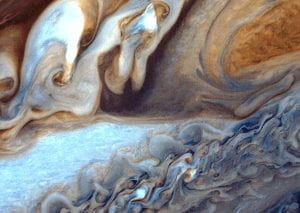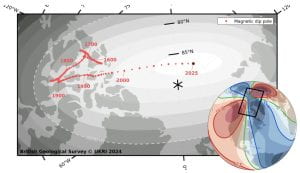Finding Areas with Substitution
I love the simplicity of the solution to this problem – finding the area of all three squares:
I love the simplicity of the solution to this problem – finding the area of all three squares:
from CNN: Scientists have made a leap forward in understanding the pattern and structure of turbulence — a natural phenomenon observed in fluids such as moving water, ocean currents, chemical reactions, blood flow, storm clouds, plumes of smoke and even the plasma of stars.

Turbulence
While turbulent flow is chaotic and irregular, physicists have long attempted to study and model the process using mathematical equations and computers. However, even with modern supercomputers, a direct and accurate simulation of all but the simplest turbulent flows remains out of reach, and a complete understanding of turbulence has eluded researchers for some 200 years. Now, an international team of scientists has pioneered a new approach to simulating turbulence that deploys a quantum computing-inspired method, described in a study published January 29 in the journal Science Advances.
The ability to accurately model and predict the phenomenon could have many practical applications in science and engineering, potentially improving the design of airplanes, cars, propellers, artificial hearts and making weather prediction more accurate, said the study’s lead author Nik Gourianov, a researcher in the department of physics at the University of Oxford.
“Turbulence was and still is an unsolved problem in the sense that we cannot exactly simulate realistic flows on computers, i.e. we still need a wind tunnel to design an aircraft wing. But advances such as ours ‘chip away’ at the problem and push the frontier,” Gourianov said. The team applied a quantum computing-inspired algorithm to turbulent flows, allowing them to compute in a few hours what would take a classical algorithm several days to do on an entire supercomputer.
Quantum computers process information in a fundamentally different way from classical computers. Traditional computers do calculations using bits: data that exists in one state at a time, a one or a zero. Quantum computers use quantum bits (or “Qbits), which can be zeros, ones or any combination of both. The study authors used a mathematical tool called tensor networks that can be used to simulate a quantum system.
James Beattie, a postdoctoral research associate and fellow in the department of astrophysical sciences at Princeton University in New Jersey, said that, by representing data with many variables in a simpler way, the team had been able to speed up complex calculations necessary to begin to understand turbulence. Beattie was not involved in the research.
“The simulation they are running is a fluid simulation of two different chemicals mixing and reacting. By using this representation, it means that this rather complex calculation can use significantly less memory, allowing it to be run on a laptop,” Beattie added.
“Seeing advances like this (a million times better utilization of memory and a thousand times speed-up in computation) is rare, making this an exciting advancement in the modeling of turbulence,” he said.
While the latest study is “amazing progress,” it is not the full story, Beattie added, noting that it doesn’t address issues of scale, or how turbulent vortices of different sizes relate to one another.
“Turbulence, as the authors say, is a multi-scale problem, i.e., turbulence can span from thousands of lightyears to less than a foot,” he said via email. “We want to know how these scales talk to each other.”
“This is an aspect that makes simulating turbulent fluids so challenging — we want to resolve many, many scales in the simulation, which take up lots and lots of memory and computation, which means putting these simulations on large supercomputers,” Beattie said.

Magnetic North Pole
If you are using your smartphone to navigate, your system just got a crucial update. Scientists have released a new model tracking the position of the magnetic north pole, revealing that the pole is now closer to Siberia than it was five years ago and is continuing to drift toward Russia.
Unlike the geographic North Pole, which marks a fixed location, the magnetic north pole’s position is determined by Earth’s magnetic field, which is in constant motion. Over the past few decades, magnetic north’s movement has been unprecedented — it dramatically sped up, then in a more recent twist rapidly slowed — though scientists can’t explain the underlying cause behind the magnetic field’s unusual behavior.
Global positioning systems, including those used by planes and ships, find magnetic north using the World Magnetic Model, as it was named in 1990. Developed by the British Geological Survey and the National Oceanic and Atmospheric Administration, this model notes the established position of magnetic north and predicts future drift based on the trajectory of the past few years. To preserve the accuracy of GPS measurements, every five years researchers revise the WMM, resetting the official position of magnetic north and introducing new predictions for the next five years of drifting.
“The more you wait to update the model, the larger the error becomes,” said Dr. Arnaud Chulliat, a senior research scientist at the University of Colorado, Boulder, and the NOAA National Centers for Environmental Information. “The way the model is built, our forecast is mostly an extrapolation given our current knowledge of the Earth’s magnetic field.”

Curves and Equations
I love this comment on a recent math video:
“Maths gives this unpredictable tension that can make you anxious because you just don’t know what numbers you end up with but yet it’s so addictively exhilarating and satisfying once a question has been solved.”

Pic
Hula hooping is so commonplace that we may overlook some interesting questions it raises: “What keeps a hula hoop up against gravity?” and “Are some body types better for hula hooping than others?” A team of mathematicians explored and answered these questions with findings that also point to new ways to better harness energy and improve robotic positioners. The results are the first to explain the physics and mathematics of hula hooping.
“We were specifically interested in what kinds of body motions and shapes could successfully hold the hoop up and what physical requirements and restrictions are involved,” explains Leif Ristroph, an associate professor at New York University’s Courant Institute of Mathematical Sciences and the senior author of the paper, which appears in the Proceedings of the National Academy of Sciences.
To answer these questions, the researchers replicated, in miniature, hula hooping in NYU’s Applied Mathematics Laboratory. They tested different shapes and motions in a series of experiments on robotic hula hoopers using 3D-printed bodies of different shapes (e.g., cylinders, cones, hourglass shapes) to represent human forms at one-tenth the size.
The results showed that the exact form of the gyration motion or the cross-section shape of the body (circle versus ellipse) wasn’t a factor in hula hooping.
“In all cases, good twirling motions of the hoop around the body could be set up without any special effort,” Ristroph explains. However, keeping a hoop elevated against gravity for a significant period of time was more difficult, requiring a special “body type”—one with a sloping surface as “hips” to provide the proper angle for pushing up the hoop and a curvy form as a “waist” to hold the hoop in place. “People come in many different body types—some who have these slope and curvature traits in their hips and waist and some who don’t,” notes Ristroph. “Our results might explain why some people are natural hoopers and others seem to have to work extra hard.” Read more, along with animations, here.
From cnn: For many people, prime numbers have faded into the background since distant grade school days. However, for Luke Durant, a 36-year-old former Nvidia programmer, prime numbers became an all-consuming passion. He devoted nearly one year and invested a considerable sum of his own money to uncover the world’s largest known prime number. A prime number is a whole number that can only be divided by 1 and itself, such as 2, 3, 5 and 7. Durant’s remarkable discovery, officially called M136279841, consists of an astounding 41,024,320 digits and marks the first prime breakthrough in almost six years.

Screenshot
Durant’s feat is notable as the first of its kind uncovered through graphics processing units, or GPUs, according to GIMPS. GPUs are known for performing mathematical equations at high speeds and processing many pieces of data simultaneously; they are in everyday devices such as smartphones or laptops, rendering high-quality graphics or training artificial intelligence networks to process extensive amounts of information efficiently.
Unlike previous successful Mersenne prime searches that used central processing units, or CPUs, the primary component of a computer that serves as its control center to run the machine’s operating system and apps, Durant’s use of graphics processing units transformed his experience.
The professional-grade GPUs that Durant employed are known for their efficiency in handling repetitive math calculations in seconds. Durant’s supercomputer also included thousands of server GPUs, crossing 24 data center regions over 17 countries, according to a statement GIMPS released.
Woltman predicts that more primes will be discovered using GPUs in the future.
“GPUs are so good at tackling difficult number crunching compared to CPUs which are suited to a wide variety of problems,” he said. “That said, don’t count CPUs out, they will still be an important part of GIMPS and may well find the next prime number.”
Durant credits much of his success to the education he received at the Alabama School of Mathematics and Science in Mobile and its supportive environment. “My interests and technical abilities are in no small part due to my fellow students and faculty at ASMS,” he said.

web pic
The Infinite Monkey Theorem is a famous thought experiment that states that a monkey pressing random keys on a typewriter would eventually reproduce the works of the Bard if given an infinite amount of time and/or if there were an infinite number of monkeys.
However, in the study published in the peer-reviewed journal Franklin Open, two mathematicians from Australia’s University of Technology Sydney have rejected this theorem as “misleading” within the confines of our finite universe.
They challenged it by looking at the Finite Monkeys Theorem, in which there is a finite amount of time and a finite number of monkeys. They took the assumption that the current population of around 200,000 chimpanzees would remain the same over the lifespan of the universe of one googol years (that’s 1 followed by 100 zeros). They also assumed that each chimpanzee would type one key per second for every second of the day, with each monkey having a working lifespan of just over 30 years.
Using these assumptions, the researchers calculated that among these randomly-typing monkeys, there is just a 5% chance that a word as simple as “bananas” would occur in the lifespan of one chimpanzee.
They found that a short sentence such as “I chimp, therefore I am” will “almost certainly never be produced by any currently living chimp,” study co-author and mathematician Stephen Woodcock, an associate professor at the University of Technology Sydney, told CNN on Friday. “By the time you’re at the scale of a full book, you’re billions of billions of times less likely,” he continued.
Woodcock and co-author Jay Falletta, a senior research consultant at the university, concluded in the study that, even with more chimpanzees or quicker typing, it is “not plausible” that monkey labor will ever be a viable tool for “developing written works of anything beyond the trivial.”
“Even if every atom in our known universe were its own universe on the scale of ours, we would still have pretty much no chance of ever seeing something as long as even a short book,” such as “Curious George,” which is around 1,800 words, “before the end of the universe,” Woodcock told CNN. (and he’s no chimp).

Screenshot
It is only a short exchange is a rather long novel, but noteworthy – from page 134 in “A Gentleman in Moscow” by Amor Towels. It might lead you down a rabbit hole to discover if Amor is mathematically inclined. Meanwhile, here is the extract:
“Here,” he said in the tone of one chipping in. “This number is not prime.”
Nina looked up with an expression of disbelief.
“Which number?”
He laid the paper in front of her and tapped a figure circled in red.
“One thousand one hundred and seventy-three.”
“How do you know it’s not prime?”
“If a number’s individual digits sum to a number that is divisible by three, then it too is divisible by three.”
There you have it – a well known math tidbit, wrapped in a conversation in a totally non-mathematical novel. Use “Prime Numbers” in the search box for more on these fascinating numbers.